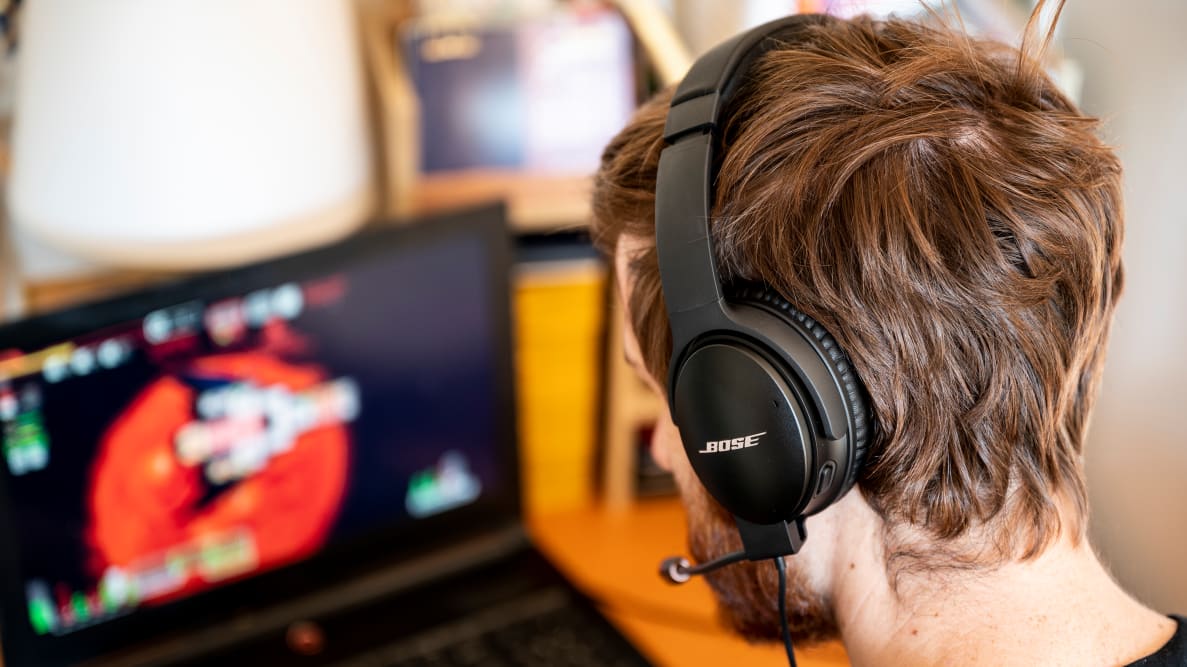Pros
-
Excellent ANC performance
-
Exceptionally comfortable
-
Great mic performance
Cons
-
Short on gaming features
-
Wired-only when gaming
-
Can't use Bluetooth while gaming
At the heart of this $329 bundle are the QuietComfort 35 II wireless headphones, which retail on their own for $299 (though that price may go down now that the newest model, the QC45, have arrived). Except for a minor change in the colorway, the headphone portion of this package is exactly the same as the standalone QC35 II. The extra $30 nets you a detachable boom microphone and a desktop volume wheel to easily adjust volume without reaching up to the headset.
That’s both good and bad. It works to the headset’s benefit because it means users can count on a versatile headset with the same great sound and noise cancellation that made the original QC35 II so popular in the first place. At the same time, it makes this “gaming headset” bundle less tailored to all your gaming adventures than most competitors in its price class.
About the Bose QuietComfort 35 II Gaming Headset
Here are the specs of the gaming headset we tested:
- Cost: $329 MSRP
- Style: Over-ear, closed-circumaural
- Ambient sound modes: Quiet mode (Acoustic Noise Cancelling), Aware mode
- Battery life: ~20 hours with ANC (depending upon usage)
- Passive operation: Yes (3.5-to-2.5mm cable included)
- Drivers: Dynamic
- Wired connections: 3.5mm analog, USB A-to-Micro-USB charging
- Microphone: Detachable boom, onboard microphones for ANC/Transparency Mode
- Voice assistant: Google, Alexa, Siri (Bluetooth-based, physical button)
- Weight: 236g (264g including mic)
- Bluetooth version: Bluetooth 4.2
- Colors: Black, Copper Highlights
- Additional Features: PC desktop controller, Bose Connect App, Bose SimpleSync, Bluetooth multipoint
Despite the headphones not being explicitly designed around gaming, the Bose QC35 II Gaming Headset bundle brings a lot to the table. The QC35 II earned a reputation as being one of the best active noise-canceling headphones on the market, competing directly with the Sony WH-1000XM3/XM4.
In the world of gaming headsets, active noise cancellation is still exceedingly rare. If you game in a noisy environment as I do, an effective way to block out the noise is a necessity. World-class ANC in a gaming headset is an incredibly appealing prospect.
What we like
Great sound on just about any device
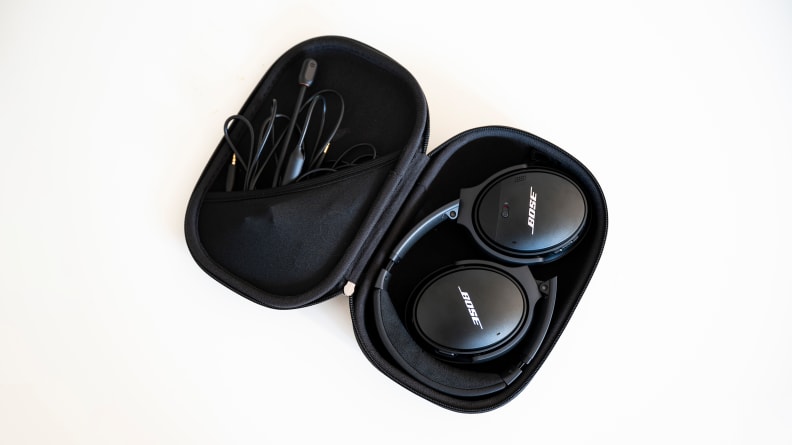
Easily store your Bose QuietComfort 35 II Gaming Headset and accessories in the included protective case.
If you’re on the hunt for one headset that can connect to just about anything and sound good doing it, the QC35 II Gaming Headset is that headset. Blending analog and digital connectivity, the QC35 II can connect to just about anything.
On PC, the Desktop Controller acts as an external soundcard, taking over your system’s audio and sending it out the analog port leading to the headset. On current and last-generation consoles (including Nintendo Switch and Switch Lite), the microphone and standard audio cables can run directly into the controllers.
Made for portable use, the speakers aren’t hard to drive, so any of these options can deliver the full audio experience you’re paying for. When you’re not using the wired connection, you can switch to Bluetooth, including Bluetooth Multipoint to stay connected to multiple devices at once.
The QC 35 II Gaming Headset doesn’t deliver the kind of detail or expansive soundstage audiophiles demand, but they still make multiple types of content sound great. The headphones have a balanced sound signature that’s great for music and movies, but when it comes to gaming, it’s an atypical tuning (most gaming headsets emphasize the bass). However, the sound won’t leave you fatigued enough to drop out of the game early.
Unparralled active noise cancellation
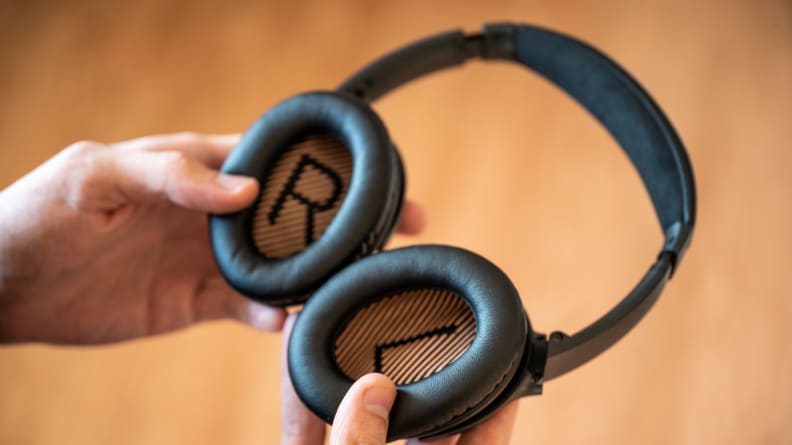
You'll never get right and left earcups confused again with those large letters!
It’s about time a major brand has delivered a gaming headset with outstanding active noise cancellation. The QuietComfort 35 II isn’t the first gaming headset to offer ANC, but it’s easily one of the best money can buy. My previous go-to, the Razer Opus, shared the same minimalist design that wouldn’t draw strange looks if you left the house, but the difference in the ANC on the QC35 II is night and day. If you want to block out the noise, whether you’re in the house or out and about, this headset excels.
One of the highlights of the ANC implementation here is that it’s effective against more than low, droning noises. Bose’s ANC algorithm is able to cancel out more mid-frequency noise, which includes the sound of clacky mechanical gaming keyboards and even some voices. Most of us do our gaming at home, away from the low drone of engines other headsets specialize in reducing. The QC35 II has great ANC in general but it shines when applied to gaming at home.
If you’re worried that enabling ANC might reduce sound quality, don’t be. There isn’t a noticeable difference either way, which turns out to be a good thing in more ways than one. Once the headset is connected over an analog connection, ANC is enabled by default and the control buttons no longer work. That means there’s no way to turn it off, the only potential downside to the ANC implementation.
The other half of the name is comfort, and the QC35 II is a masterclass in how to design a headset that can be worn for hours with ease. The lightweight build (only 264 grams), soft ear cushions, and effective head padding prevent sore spots from developing. I’m a glasses wearer and, while I don’t consider myself overly sensitive, many headsets do make the area behind my ears sore. That wasn’t the case here, even after an extended, five-hour stretch. The similarly premium Audeze Penrose gaming headset, in contrast, became uncomfortable for me after gaming for only two to three hours.
Everything from weight, to clamp force, to the adjustability of the earcups is finely tuned to make the QC35 II comfortable to wear all day long, but that doesn’t mean Bose left fit and finish by the wayside. The logo on each earcup and the inner mesh lining the cushions are now copper, which looks great without screaming “gaming headset.” Despite its light weight, the headset also makes effective use of metal on the face of each earcup and within the adjustable headband for added robustness.
Crystal clear comms

Anyone looking for a headset that also doubles a fantastic pair of headphones should consider this gaming headset from Bose.
Given the modest $30 price increase from the standard QC35 II, it’s clear that the bulk of what you’re paying for is the microphone and desktop controller—and it’s a worthy investment. The microphone here is great, easily outperforming the built-in microphones available on most gaming headsets. I compared it to against a handful of popular headsets, including two from our Best Gaming Headsets of 2021 list: the Audeze Penrose X, the HyperX Cloud Alpha S, and even the Logitech Pro X gaming headset (which sells itself on its microphone quality), and the mic on the QC35 II was the best of the bunch.
I tested the microphone in the QC35 II Gaming Headset across matches with friends, Google Meet conferences for work, and in isolated recordings using the free recording software, Audacity. My teammates and colleagues were able to hear me clearly and it’s no wonder why: In isolated recordings, the mic sounds full-bodied and crisp. It doesn’t tend into muddiness due to too much bass and is quite effective at blocking out external noise.
The small microphone capsule and environmental noise-canceling did add a slight artificial tinge to my voice making it sound a bit too crisp to be true to life, so don’t throw away your Blue Yeti USB mic yet. Still, the performance is impressive and much closer to premium third-party headset mics, like the Antlion ModMic or V-Moda Boom Pro.
What we don’t like
Short on gaming features
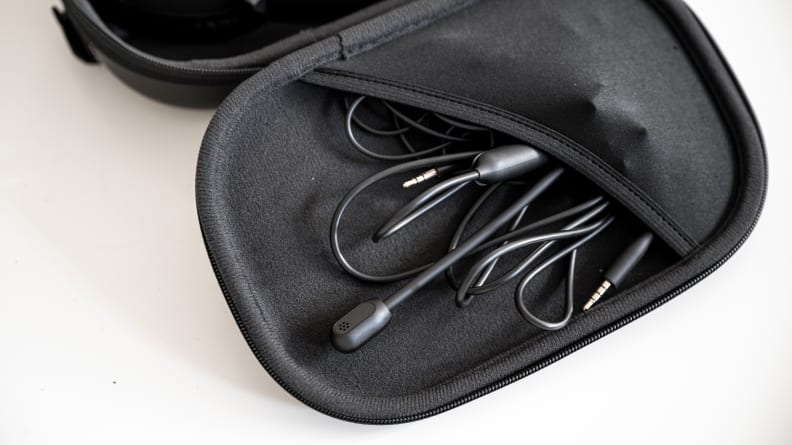
Unfortunately, using the headsets in wireless mode creates too much sound lag for gaming.
Let’s be real: the QC35 II Gaming Headset is much more of a microphone bundle than it is a true gaming headset. Bose hasn’t done anything to the headphones to tailor them for gaming, other than adding copper accents—and a mic, of course. That means that these are music headphones you’ll be using for gaming, not a completely new product designed to give you an edge on the battlefield.
Compared to more dedicated gaming headsets, like the Audeze Penrose, there is a distinct lack of gaming features. There’s no game/chat mixer to balance the audio sources making their way into your ears. There are no special modes to bring out audio cues like footsteps. You can’t tilt the microphone to mute it.
In fact, you can’t completely mute the microphone at all. Instead, flipping the in-line mute switch only attenuates the signal to near inaudible levels. The desktop controller mitigates the effect by lowering the volume of your output overall, but if you plug directly into the PC and talk loudly, the person on the other end can hear what you’re saying even when you’re muted, albeit in muffled form.
The desktop audio controller is also a big missed opportunity to deliver virtual surround/spatial audio features. Even though it acts as a soundcard, it’s stereo only, so virtual 5.1 and 7.1 surround sound is out. If you want those features, you’re stuck with Windows Sonic, buying a Dolby Atmos license, or using the built-in codec on PlayStation 5.
Additionally, the headset doesn’t have a sound profile that’s tuned for gaming. The headphones still produce good sound, but the balanced sound signature makes these cans sound a bit flatter than your average gaming headset. Bass isn’t as powerful, and important details like footsteps don’t pop out from the mix as much. It would have been nice to see Bose add a customizable EQ to its Connect app so users could tweak the sound themselves, but it’s currently not an option, so this headset is probably not one you’d want to turn to for a competitive advantage.
Wired-only connection for gaming
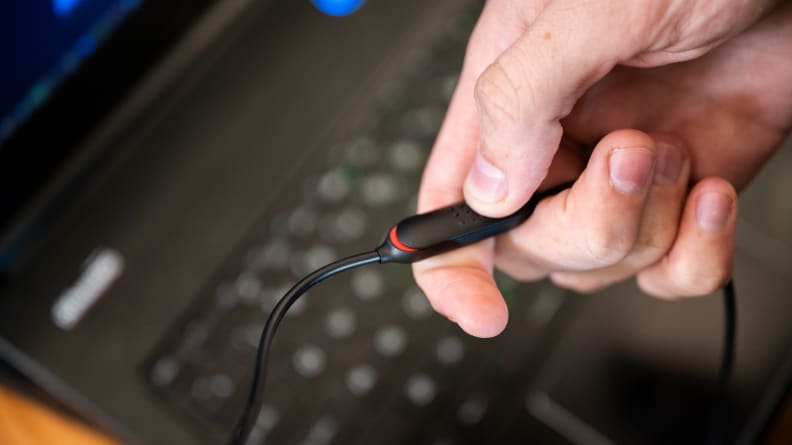
In-line controls on the headset's wired connection make it easy to adjust the volume.
You might think that because it’s based around a premium (and expensive) pair of wireless headphones that the QC35 II Gaming Headset is also wireless, but unfortunately, no. Though you can connect to your PC wirelessly over Bluetooth (if your PC supports it), without support for low latency Bluetooth codecs like aptX Low Latency, there is a noticeable delay between clicking your mouse and seeing a shot fire on-screen. So that means you can use the headset wirelessly for virtually anything else except gaming.
As a fan of many wired headphones, I’m not one to cut the cord prematurely. But at such a high price point for a gaming headset, the lack of wireless support stands out as a big downside compared to the competition.
You can’t use Bluetooth while gaming
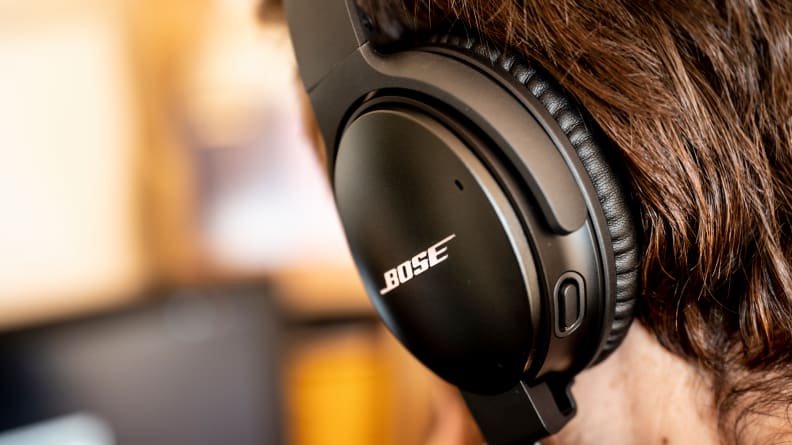
The Bose QuietComfort 35 II Gaming Headsets lacks a few notable gaming features, like the option to individually adjust in-game chat and game volume.
If you’re dreaming of using the QC35 II Headset to take calls over Bluetooth in the middle of your game, keep dreaming. Unlike premium sets like the Steelseries Arctis 9x, another one of our best gaming headsets of 2021, the QC35 II instantly ends the Bluetooth connection when you plug in the mic or the audio cable. This also makes it impossible to adjust important features, like the ANC level, or adjust the volume on the headset if you’re not using the desktop controller.
Should you buy it?
Maybe, if you love noise canceling and want a single headset for everything
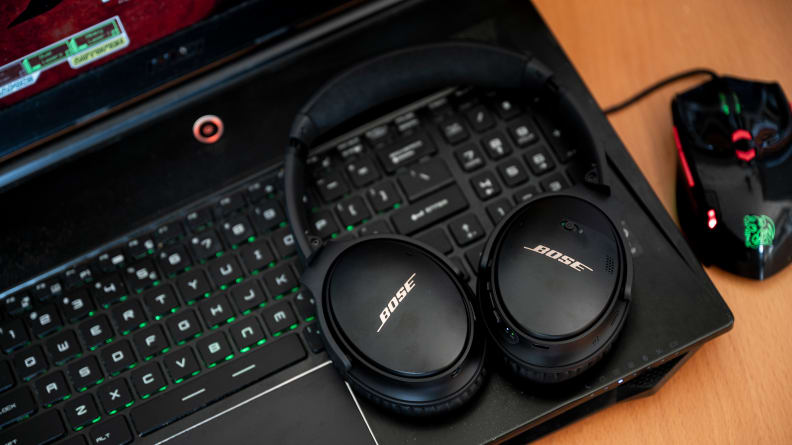
Active noise canceling is probably one of the best features of any gaming headset.
Even though the Bose QC35 II Gaming Headset is more of a microphone bundle than something truly designed for gaming, it’s hard to argue that it’s not a great headset overall. If you’re in the market for a pair like the QC35 II, spending $30 more to get a great microphone and desktop controller for gaming is a compelling way to add versatility to an already impressive setup.
If you’re looking for an advantage in your latest match of Call of Duty, there are better options for less money, like the SteelSeries Arctis Pro, which lets you balance the volume levels of your voice chat and in-game sounds and music, or the Razer Kraken Ultimate, which has an ANC-equipped microphone, and THX Spatial and 7.1-channel emulation. The QC35 II isn't a headset that will give you a one-up on enemy locations or impress you with the impact of its bass. Instead, its balanced sound signature and lack of spatial audio is something you’re going to have to live with in exchange for its versatility and ability to leave you on an island of solitude with its excellent ANC.
The QC35 II is perfect for listeners who would rather buy one great pair of headphones and use them everywhere than have a separate pair for every activity. The QC35 II was already a great option before Bose added a microphone, and now it’s a great versatile gaming headset—but if you're a serious gamer you may need to look elsewhere.
Meet the tester
Chris has been specializing in PC and audio-related tech since 2015. Find him at IGN, Tom's Hardware, PC Perspective, MMORPG.com, and more.
Checking our work.
Our team is here to help you buy the best stuff and love what you own. Our writers, editors, and experts obsess over the products we cover to make sure you're confident and satisfied. Have a different opinion about something we recommend? Email us and we'll compare notes.
Shoot us an email